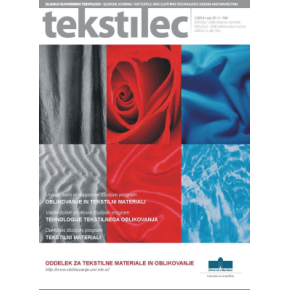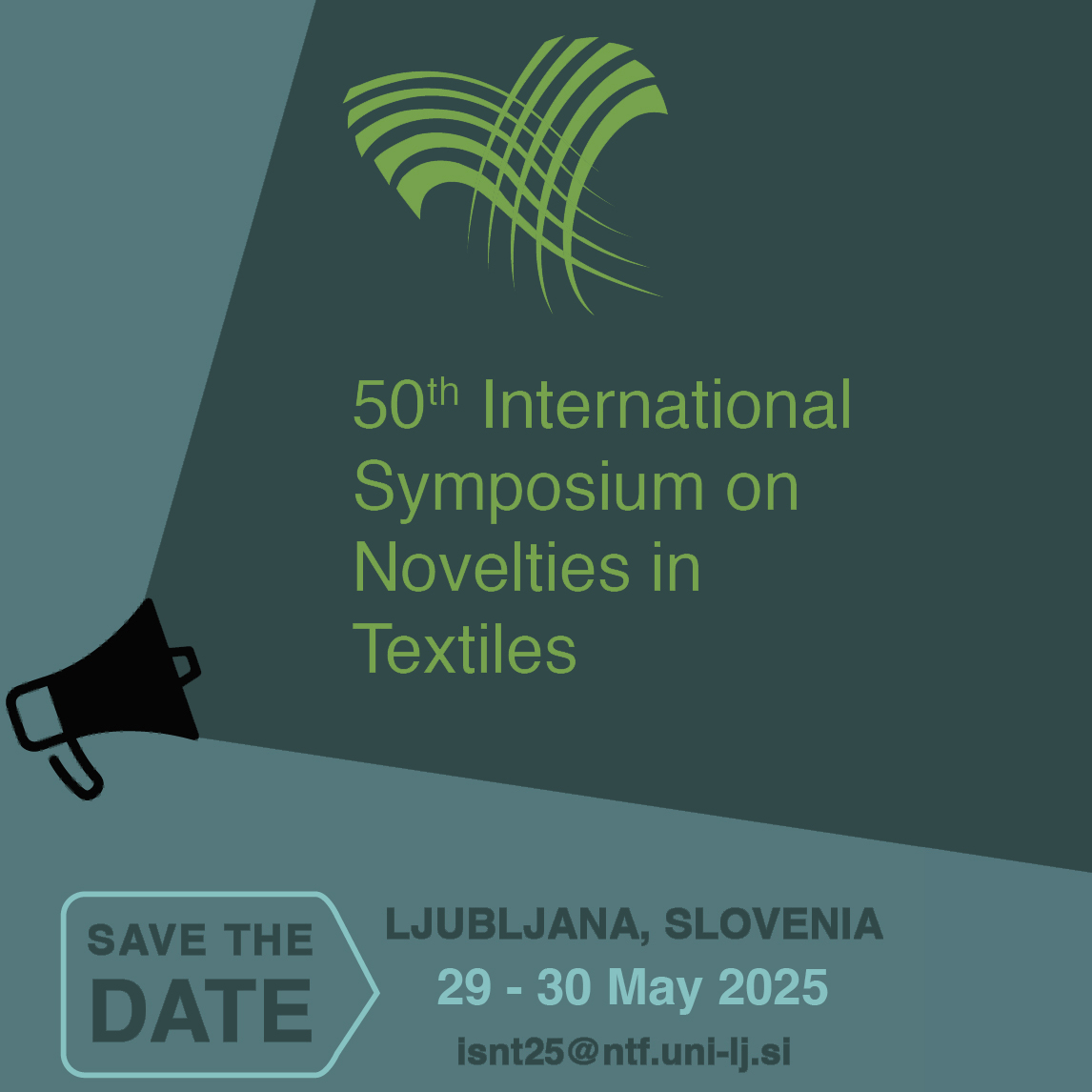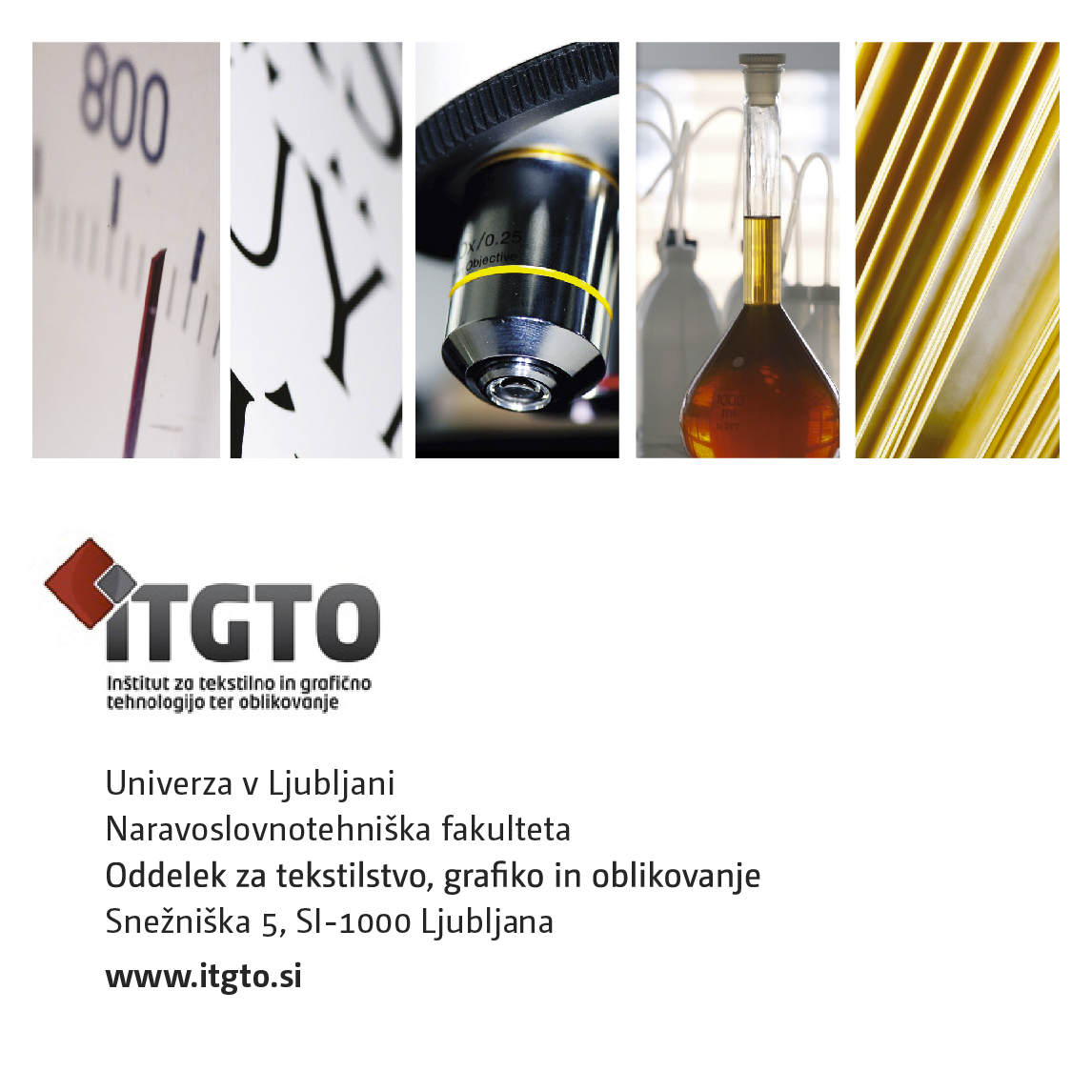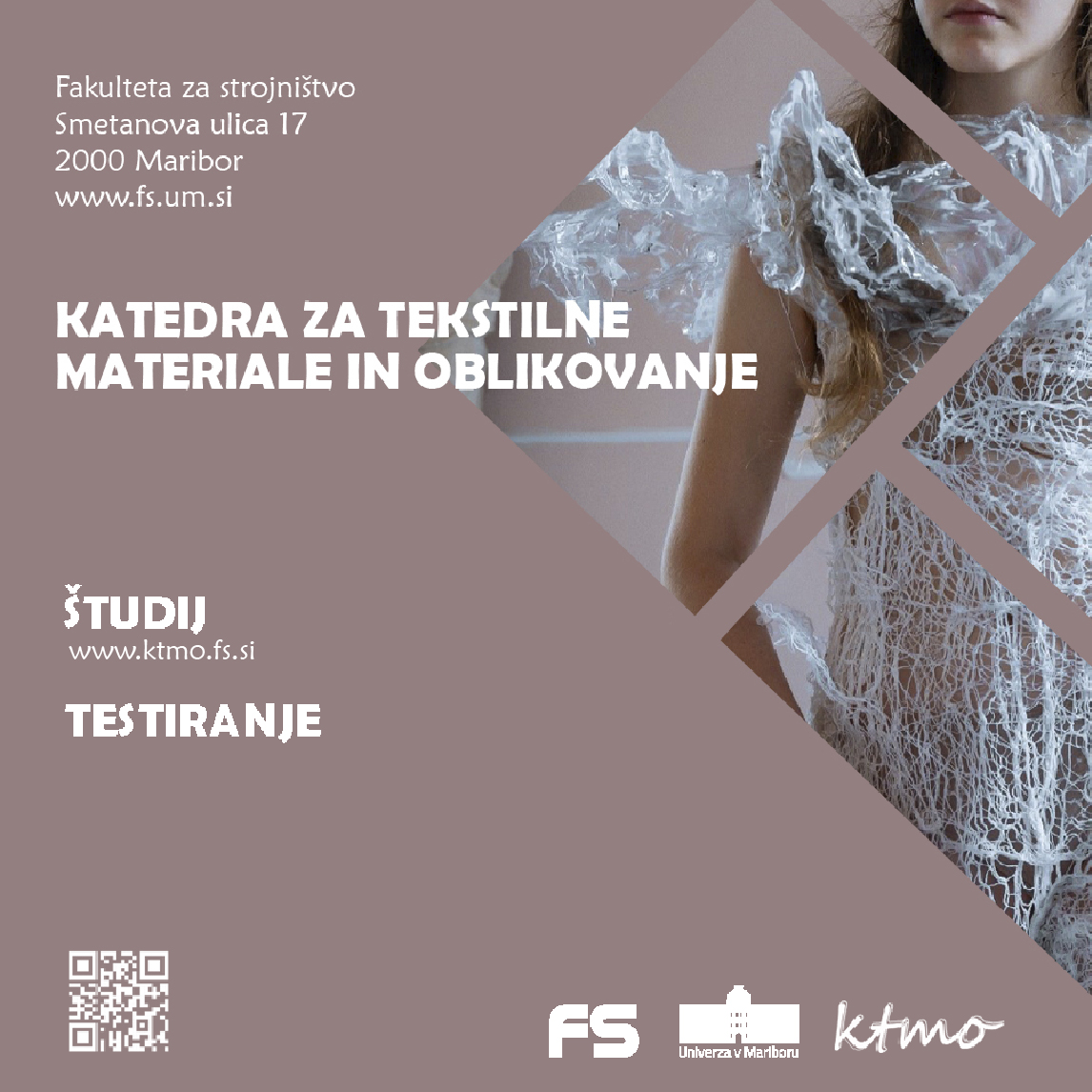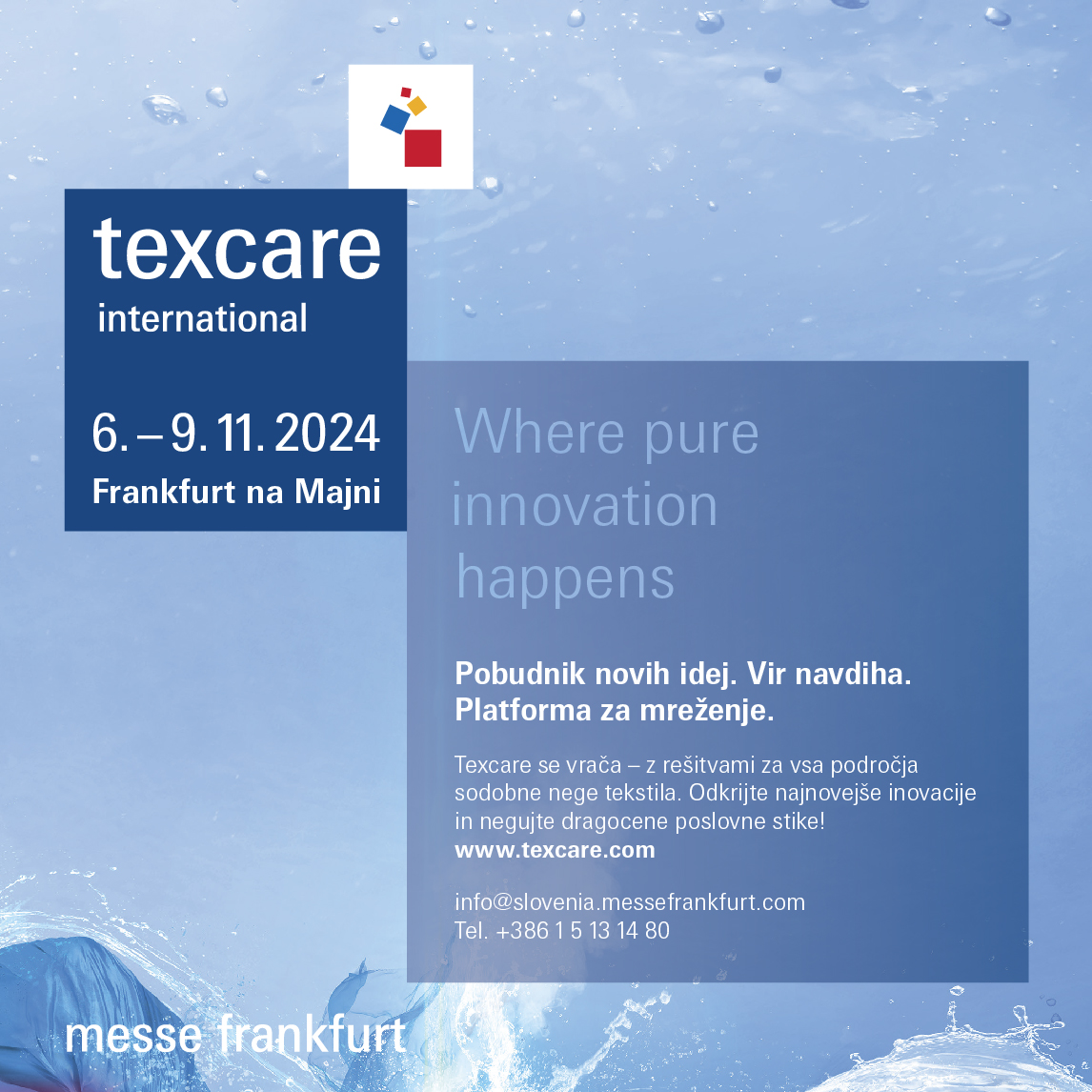CONTENTS
SCIENTIFIC PAPERS
4 Application of Microtomography in Textile Metrology Acid • Katarina Doczyova, Viera Glombikova and Petra Komarkova Abstract and References
Technical University of Liberec, Faculty of Textile Engineering, Department of Clothing Technology, Liberec, Czech Republic
Original Scientific Paper
Received/12-2013 • Accepted/01-2014
Corresponding author:
Ph.D. Viera Glombikova, Ing.
Telephone: +420 485 353 124
E-mail: viera.glombikova@tul.cz
Abstract
Porosity represents one of the parameters of knitted fabrics, which significantly affects their air permeability and thus the overall physiological comfort of knitted clothes. X-ray computed microtomography (µCT) is a relatively new but not yet widely used method for studying textile porosity. The paper discusses the use of a 3D image of the textile structure obtained by applying μCT in the textile metrology. Specifically, it deals with the analysis of options for determining the 3D porosity of knitted fabric by μCT and subsequent analysis of the relationship of porosity versus the fabric permeability to air. The first part of the article was aimed to analyse the suitability of application of µCT to determine the 3D porosity of textile materials and determination of appropriate measurement conditions. Obtained porosity data measured by the 3D device SkyScan 1174 was compared to the porosity calculated by the standard mathematical model. The research results show that μCT system is suitable alternative method for 3D porosity measurement. There is very small difference (about 6%) between the percentage of the air volume of the examined knitted fabric obtained by µCT (64.6%) and porosity expressed through the volume fraction by standard mathematical model (70.6%). The last part analyses the dependent relationship between porosity of the knitted structures obtained by using μCT SkyScan 1174 and air permeability measured on FX device 3300 according to EN ISO 9237. Analysis between air permeability and measured porosity of others knitted structures verified correctness of suggested measurement process of 3D porosity.
Keywords: micro CT, 3D porosity, knitted fabric, air permeability, 3D model of knitted fabric
References
- ČUDEN PAVKO, Alenka. Geometrical models of weft knitted loop: open, normal and compact structure. Tekstilec, 2010, 53(4−6), 113−138.
- HAVLOVÁ, Marie. Air permeability and constructional parameters of woven fabrics. Fibres and Textiles in Eastern Europe, 2013, 98(2), 84−89.
- HO, Saey Tuan, HUTMACHER, Dietmar W. A comparison of micro CT with other techniques used in the characterization of scaffolds. Biomaterials, 2006, 27(8), 1362–1376, <http://dx.doi.org/10.1016/j.biomaterials.2005.08.035.
- MCENANEY, Brian, MAYS, Timothy J. Characterization of macropores using quantitative microscopy. Studies in Surface Science and Catalysis, 1994, 87, 327–337, <http://dx.doi.org/10.1016/S0167-2991(08)63093-1>.
- RAMASWAMY, S., GUPTA, M., GOEL, A., AALTOSALMI, U., KATAJA, M., KOPONEN, A., RAMARAO, B. V. The 3D structure of fabric and its relationship to liquid and vapor transport. Colloids and Surfaces A: Physicochemical and Engineering Aspects, 2004, 241, 323−333, <http://dx.doi.org/10.1016/j.colsurfa.2004.04.023>.
- SHINOHARA, T. Expression of individual woven yarn for structure analysis of textile fabric based on fuzzy clustering of three dimensional CT image. Ieeexplore, 2011, Japan, [online], [18.5.2013]. Available on: <http://ieeexplore.ieee.org/stamp/stamp.jsp?arnumber=06119651&tag=1>.
- DESPLENTERE, Frederik, LOMOV Stepan V., WOERDEMAN, D. L., VERPOEST, I., WEVERS, Martine, BOGDANOVICH, Alexander E. Micro-CT characterization of variability in 3D textile architecture. Composites Science and Technology, 2005, 65(13), 1920–1930, <http://dx.doi.org/10.1016/j.compscitech.2005.04.008>.
- STÄMPFLI, Rolf, BRUHWILER, Paul A., RECHSTEINER, Ivo, MEYER, Veronika R., ROSSI, Rene M. X-ray tomographic investigation of water distribution in textiles under compression – Possibilities for data presentation. Measurement, 46(3), 2013, 1212–1219, <http://dx.doi.org/10.1016/j.measurement.2012.11.009>.
- ČUDEN P., Alenka, KUPLJENIK, Anže. Knitted fabrics from bamboo viscose. Tekstilec, 2012, 55(1), 12–18, [online], [19.11.2013]. Available on: <http://www.tekstilec.si/wp-content/uploads/2012/01/Knitted-Fabrics-from-Bamboo- Viscose.pdf>.
- OGULATA, R. Tugrul, MAVRUZ, Serin. Investigation of porosity and air permeability values of plain knitted fabrics. Fibres & Textiles In Eastern Europe, 2010, 18(5), 71–75, <http://www.tandfonline.com/doi/abs/10.1080/00405000903474907#.UywHbfldVL4>.
- KAŤUCH, Peter, ŽIVČÁK, Jozef. Priemyselná tomografia. Nový rozmer v metrológii. 2010, [online], [21.6.2013]. Available on: <http://web.tuke.sk/smetrologia/podklady/metro2010.pdf>.
- Manual for Bruker-microCT CT-Analyser v. 1.13. Ctan_usermanual.pdf, 2013, [online], [1.3.2013]. Available on: <http://www.skyscan.be/next/ctan_usermanual.pdf>.
- NECKÁŘ, Bohuslav, DAS, Dipayan. Theory of structure and mechanics of fibrous assemblies. Woodhead Publishing Limited, 2012, 310, <http://dx.doi.org/10.1533/9780857093028>.
- ČUDEN PAVKO, Alenka. Parameters of compact single weft knitted structure (Part 1): Loop modules and munden constants – State of research. Tekstilec, 2010, 53(7−9), 205–214, [online], [19.11.2013]. Available on: <http://www.tekstilec.si/wp-content/uploads/2010/08/Parametri-zbitega-levo-desnega-pletiva-1.-del_moduli-zanke-in-Mundenove-konstante-%E2%80%93-stanje-raziskav.pdf>.
12 Analysis and Development of Algorithm for Solving Complaints of Consumers • Urška Stankovič Elesini1, Sabina Kodarin1,Jože Urankar2, Andreja Potočnik3 and Primož Weingerl1 Abstract and References
1 University of Ljubljana, Faculty of Natural Sciences and Engineering, Department of Textiles, Snežniška 5, 1000 Ljubljana
2Acourt Expert and Valuer for Textile and Leather-Fur Field, Brezovica pri Dobu 12A, 1233 Dob
3City of Ljubljana, Department Department for Commercial Activities and Traffic, Trg MDB 7, 1000 Ljubljana
Original Scientific Paper
Received 02-2014 • Accepted 02-2014
Corresponding author:
izr. prof. dr. Urška Stankovič Elesini
Telephone: +386 1 200 32 29
E-mail: urska.stankovic@ntf.uni-lj.si
Abstract
Depending on their expectations about the product, consumers can be satisfied, dissatisfied or impressed when they purchase a product. When they are dissatisfied with the product, they have the right to complain. They can enforce their rights from clerical errors. If the fault is not contested, companies must meet the consumers’ demands. If the fault is contested and the company does not recognize it, the consumers must decide whether to continue with the process of complaint. Ten hypotheses concerning the complaint procedure were developed in this research. They were made on the primary and secondary data basis. The primary data were obtained from long experienced work within the Textile and Leather Development Monitoring Committee. The hypotheses cover the consumers’ knowledge about the rights arising from clerical errors, the reasons for complaints and dealing with the question of why consumers in solving complaints do not turn to third parties more often, especially when a company does not react to the consumer’s complaint, leading to the consumer disagreeing with such a solution. The data for verifying the hypotheses were obtained by means of an online questionnaire. To verify the hypothesis of equal probability and the hypothesis of independence, the Pearson’s χ2 test was used. The Cochran Q test was used when several answers were possible. On the basis of accepted/rejected hypotheses and corresponding findings, the algorithm for solving complaints was developed. The algorithm specifies the procedure of solving complaints in a demonstrable and understandable way.
Keywords: consumer, complaint, third-party, questionnaire, algorithm
References
- Potočnik, Vekoslav. Trženje v trgovini. Ljubljana : GV Založba, 2001, 110−113, 328−330.
- DAMJAN, Janez, MOŽINA, Stane. Obnašanje potrošnikov. Ljubljana : Univerza v Ljubljani, Ekonomska fakulteta, 1998, 132−133.
- MOŽINA, Stane, ZUPANČIČ, Vinko, POSTRUŽNIK, Natalija. Trg, trgovina in potrošnik. Maribor : Založba Pivec, 2010, 323−388.
- KOTLER, Philip. Management trženja. Ljubljana : GV Založba, 2004, 60–65.
- VUKOVIČ, Goran, ZAVRŠNIK, Bruno, JERMAN, Damjana. Reševanje reklamacij v e-prodajalni. V Nove tehnologije, novi izzivi / 28. mednarodna konferenca o razvoju organizacijskih znanosti, Portorož, 25.−27. marec 2009. Kranj : Moderna organizacija, 2009, 1613−1619.
- MUSEK LEŠNIK, Kristjan. Od zadovoljstva potrošnikov do programov zvestobe: nekateri psihološki dejavniki zadovoljstva in zvestobe potrošnikov in njihova integriranost v programe za sistematično spodbujanje zadovoljstva, zvestobe in želenega vedenja potrošnikov. Koper : Fakulteta za management, 2008, 23−43.
- MUROVEC, Nika, PRODAN, Igor. Dejavniki zaviranja pritožb potrošnikov in njihov pomen za podjetje. Naše gospodarstvo : revija za aktualna gospodarska vprašanja, 2006, 52(5/6), 52−59.
- BISHOFF, Christo. An experimental study of service recovery options. International Journal of Service Industry Management, 1997, 8(2), 110–130, <http://dx.doi.org/10.1108/09564239710166245>.
- CORNWELL, T. Bettina, BLIGH Alan David, BABAKU, Emin. Complaint behavior of Mexican-American consumers to a third-party agency. Journal of Consumer Affairs, 1991, 25(1), 1–18, <http://dx.doi.org/10.1111/j.1745-6606.1991.tb00278.x>.
- ŠIRCA, Erika. Kako do zadovoljnih kupcev. Podjetnik, april 2008, 50−51.
- Zakon o varstvu potrošnikov. Uradni list Republike Slovenije, 2004, 98, 11845−11861.
- Obligacijski zakonik. Uradni list Republike Slovenije, 2007, 97, 13125−13136.
- Pregled stanja potrošniških trgov. Zagotavljanje učinkovitosti trgov v korist potrošnikov. Četrta izdaja – oktober 2010 [dostopno na daljavo] European Commission. Healthand Consumers. [citirano 20. 1. 2013]. Dostopno na svetovnem spletu: <http://ec.europa.eu/consumers/consumer_research/editions/docs/4th_edition_scoreboard_sl.pdf>.
- Consumer Markets Scoreboard. Making Markets Work for Consumers. 8th edition – December 2012 [dostopno na daljavo] European Commission. Healthand Consumers. [citirano 20. 1. 2013]. Dostopno na svetovnem spletu: <http://ec.europa.eu/consumers/consumer_research/editions/docs/8th_edition_scoreboard_en.pdf>.
- Pregled stanja potrošniških trgov: kje v Evropi so razmere za potrošnike najboljše? [dostopno na daljavo] Evropska komisija – sporočilo za medije [citirano 20. 1. 2013] Dostopno na svetovnem spletu: <http://europa.eu/rapid/press-release_IP-12-510_sl.htm>.
- Navodila za oddajo reklamacije potrošnika [dostopno na daljavo]. Tržni inšpektorat Republike Slovenije [citirano 05. 02. 2014]. Dostopno na svetovnem spletu: <http://www2.gov.si/mg/tirs/tirs.nsf/f1?OpenFrameSet&Frame=main&Src=/mg/tirs/tirs.nsf/0/838F0883B0BAFDC8C1256CC400393325>.
- Če ima izdelek stvarno napako [dostopno na daljavo]. Zveza potrošnikov Slovenije 2012. [citirano 05. 02. 2014]. Dostopno na svetovnem spletu: <http://www.zps.si/pravice/stvarna-napaka/index.php?Itemid=633>.
- Poslovno poročilo Tržnega inšpektorata Republike Slovenije za leto 2008 [dostopno na daljavo]. Tržni inšpektorat Republike Slovenije [citirano 23. 01. 2013] Dostopno na svetovnem spletu: <http://www.ti.gov.si/si/zakonodaja_in_dokumenti/dokumenti/>.
- Poslovno poročilo Tržnega inšpektorata Republike Slovenije za leto 2009 [dostopno na daljavo]. Tržni inšpektorat Republike Slovenije [citirano 23. 01. 2013] Dostopno na svetovnem spletu: <http://www.ti.gov.si/si/zakonodaja_in_dokumenti/dokumenti/>.
- Poslovno poročilo Tržnega inšpektorata Republike Slovenije za leto 2010 [dostopno na daljavo]. Tržni inšpektorat Republike Slovenije [citirano 23. 01. 2013] Dostopno na svetovnem spletu: <http://www.ti.gov.si/si/zakonodaja_in_dokumenti/dokumenti/>.
- Poslovno poročilo Tržnega inšpektorata Republike Slovenije za leto 2011 [dostopno na daljavo]. Tržni inšpektorat Republike Slovenije [citirano 23. 01. 2013] Dostopno na svetovnem spletu: <http://www.ti.gov.si/si/zakonodaja_in_dokumenti/dokumenti/>.
- Poslovno poročilo Tržnega inšpektorata Republike Slovenije za leto 2012 [dostopno na daljavo]. Tržni inšpektorat Republike Slovenije [citirano 06. 03. 2013] Dostopno na svetovnem spletu: <http://www.ti.gov.si/si/zakonodaja_in_dokumenti/dokumenti/>.
- RAPEX [dostopno na daljavo]. Tržni inšpektorat RS [citirano 28. 1. 2014] Dostopno na svetovnem spletu: <http://www.ti.gov.si/si/delovna_podrocja/varnost_proizvodov/rapex/>.
- LOZAR MANFREDA, Katja, BERZELAK, Jernej, VEHOVAR, Vasja. Programska orodja za družboslovne ankete na spletu. Teorija in praksa, 2006, 43(5–6), 792–813.
- MojaAnketa.si [dostopno na daljavo]. [citirano 25. 02. 2014]. Dostopno na svetovnem spletu: <http://www.mojaanketa.si/surveys/>.
- SHESKIN, J. David. Handbook of Parametric and Nonparametric Statistical Procedures: Third Edition. CRC Press, 2003, 881−98.
32 Visual and Functional Properties of Digital Printed and Finished Anaglyph Pictures on Cotton Fabric • Špela Zakrajšek, Danaja Štular, Špela Vasič Stepančič, Brigita Tomšič, Marija Gorjanc, Barbara Simončič in Petra Forte Tavčer Abstract and References
University of Ljubljana, Faculty of Natural Sciences and Engineering, Department of Textiles, Snežniška 5, 1000 Ljubljana
Original Scientific Paper
Received 11-2013 • Accepted 01-2014
Corresponding author:
prof. dr. Petra Forte Tavčer
Telephone: +3861 200 32 93
E-mail: petra.forte@ntf.uni-lj.si
Abstract
The aim of the study was to examine the influence of various protective finishes on the visual properties of anaglyph images and CMYK primary colours digitally printed on a cotton fabric. Using the impregnation process, one-component water- and oil-repellent, and flame retardant finishes, as well as their combination were subsequently applied on the printed samples. A visual evaluation was determined for the 3D visual effect of printed samples before and after the finishing, one and five washings, and after seventy-two hours of exposure to artificial light. The colour fastness of prints after repeated washing, exposure to artificial light, dry and wet rubbing was determined. The repellence properties of studied finishes were studied by measuring the contact angles of water and n-hexadecane, while the vertical flammability test was used for the determination of flame retardancy. The wash fastness of the studied finishes was also taken into observation. The results showed that the presence of finishes changed the colour properties of prints; however, it did not impair the 3D effect of the anaglyph image, which was maintained even after repeated washings and exposure to artificial light. The presence of finishes improved the wash fastness of the M and Y colour, and impaired the wash fastness of the C and K colour. The light fastness of unfinished printed samples was poor, but it improved for the M, Y and K colours after the application of finishes. The prints did not influence the functional repellent and flame retardant properties. However, the impaired wash fastness of finishes was observed.
Keywords: cotton fabric, digital printing, anaglyph images, 3D effects, colour fastness, influence of finish
References
- ŠTULAR, Danaja. Digitalni tisk anaglifnih slik na tekstil: diplomsko delo. Ljubljana 2012, 68.
- AHTIK, Jure. Tehnike upodabljanja anaglifnih slik za uporabo v umetnosti : magistrsko delo. Ljubljana 2011, 118.
- FORTE TAVČER, Petra, ŠTULAR, Danaja, AHTIK, Jure. Digital printing of anaglyph images onto textile. Textile ve Konfeksiyon, 2013, 23(4), 381−386.
- Sakashita, R., Fujisawa, N., Matsuura, F., Takizawa, K. Anaglyph stereo visualization of rhythmical movements. Journal of Visualization, 2007, 10(4), 345−346, <http://dx.doi.org/10.1007/BF03181891>.
- MATSUURA, F., FUJISAWA, N. Anaglyph stereo visualization by the use of a single image and depth information. Journal of Visualization, 2008, 11(1), 79−86, <http://dx.doi.org/10.1007/BF03181917>.
- WOODS, Andrew J., HARRIS, Chris R., LEGGO, Dean B., ROURKE, Tegan M. Characterizing and reducing crosstalk in printed anaglyph stereoscopic 3D images. Optical Engineering, 2013, 52(4), <http://dx.doi.org/10.1117/1.OE.52.4.043203>.
- OCEPEK, Barbara, BOH, Bojana, ŠUMIGA, Boštjan, FORTE TAVČER, Petra. Printing of antimicrobial microcapsules on textiles. Coloration Technology, 2012, 128(2), 95−102, <http://onlinelibrary.wiley.com/doi/10.1111/j.1478-4408.2011.00349.x/abstract>.
- MIKUŽ, Mašenka., TURK ŠOSTAR, Sonja, FORTE TAVČER, Petra. Properties of ink-jet printed, ultraviolet-cured pigment prints in comparison with screen-printed, thermo-cured pigment prints. Coloration Technology, 2004, 126(5), 249−255, <http://dx.doi.org/10.1111/j.1478-4408.2010.00254.x>.
- EL-MOLLA, Mohamed, EL-HALWAGY, Azza. A., EL-SAYAD, H. S. Transfer printing of cellulosic and proteinic fabrics. Advances in Polymer Technology, 2001, 20(4), 296–304, <http://dx.doi.org/10.1002/adv.10004>.
- FORTE TAVČER, Petra. Tehnologija tiskanja tekstilij, Ljubljana : Univerza v Ljubljani, Naravoslovnotehniška fakulteta, 2010, 78.
- MHETRE, Shamal, CARR, Wallace, RADHAKRISHNAIAH, Parachuru. On the relationship between ink-jet printing quality of pigment ink and the spreading behavior of ink drops. The Journal of Textile Institute, 2010, 101(5), 423−430, <http://dx.doi.org/10.1080/00405000802449984>.
- KAIMOUZ, Ahmad Wassim, WARDMAN, Roger H., CHRISTIE, Robert M. Ink-jet printing process for lyocell and cotton fibers. Part 2: The relationship of colour strength and dye fixation to ink penetration. Coloration Technology, 2010, 126, 342−347, <http://dx.doi.org/10.1111/j.1478-4408.2010.00267.x>.
- WANG, X., YIN, Yunjie, WANG, Chaoxia. New approach to impart antibacterial effect and improve ink jet printing properties with modified SiO2 sols containing cationic biocides. Colloids and Surfaces A: Physicochemical and Engineering Aspects, 2010, 361, 51−55, <http://dx.doi.org/10.1016/j.colsurfa.2010.03.007>.
- YUEN, C. W. M., KU, S. K. A., KAN, C. W. in CHOI, P. S. R. A Two-bath method for digital ink-jet printing of cotton fabric with chitosan. Fiber and Polymers, 2011, 8(6), 625−628; <http://dx.doi.org/10.1007/BF02876000>.
- YANG, Yiqi, NAARANI, Vamshi. Effect of steaming conditions on colour and consistency of ink-jet printed cotton using reactive dyes. Coloration Technology, 2004, 120, 127−131, <http://dx.doi.org/10.1111/j.1478-4408.2004.tb00218.x>.
- KAN, C. W., YUEN, C. W. M. in TSOI, W. Y. Using atmospheric pressure plasma for enhancing the deposition of printing paste on cotto fabric for digital ink-jet printing. Cellulose, 2011, 18, 827−839, <http://dx.doi.org/10.1007/s10570-011-9522-2>.
- KOSOLIA, Chrysavgi Th., TSATSARONI, Eforia, NIKOLAIDIS, Nikolaos F. Disperse ink-jet inks: properties and aplication to polyester fibre. Coloration Technology, 2011, 127, 357−364, <http://dx.doi.org/10.1111/j.1478-4408.2011.00334.x>.
- YUEN, C. W. M., KAN, C. W., JIANG, S. Q., KU, S. K.A., CHOI, P. S. R. in WONG, K. Y. Optimum condition of ink-jet printing for wool wabric. Fiber and Polymers, 2010, 11(2), 229−233, <http://dx.doi.org/10.1007/s12221-010-0229-z>.
- YANG, Yiqi, LI, Shiqi. Cotton fabric inkjet printing with acid dyes. Textile Research Journal, 2007, 73(9), 809−814, <http://dx.doi.org/10.1177/004051750307300910>.
- PHATTANARUDEE, K., CHAKVATTANATHAM, K in KIATKAMJORNWONG, S. Pretreatment of silk fabric with amino compounds for ink jet printing. Progress in Organic Coatings, 2009, 64, 405−418, <http://dx.doi.org/10.1016/j.porgcoat.2008.08.002>.
- RENFREW, A in HUNTER, M. Reactive dyes for textile fibres : the chemistry of activated [pi]-bonds as reactive groups and miscellaneous topics. Bradford : Society of Dyers and Colourists, 1999, 217.
- FORTE TAVČER, Petra, KERT, Mateja, Tiskanje tekstilij – navodila za vaje. Ljubljana, 2010, 89.
- GORJANC, Marija, JAZBEC, Katja, MALOPRAV, Anja, GODEC, Mateja, FORTE TAVČER, Petra, SIMONČIČ, Barbara. Oblikovanje »lotosovega efekta« na bombažni tkanini s plazmo, encimi in apreturo sol-gel. Tekstilec, 2012, 55(3), 206−214.
- ČERNE, Lidija, HADŽIĆ, Samira, SIMONČIČ, Barbara. Določitev optimalne koncentracije sredstev za pripravo večfunkcionalne vodo- in oljeodbojne ter ognjevarne apreture. Tekstilec, 2013, 56(1), 13−21.
- SIMONČIČ, Barbara, TOMŠIČ, Brigita, ČERNE, Lidija, OREL, Boris, JERMAN, Ivan, KOVAČ, Janez, ŽERJAV, Metka, SIMONČIČ, Andrej. Multifunctional water and oil repellent and antimicrobial properties of finished cotton: influence of sol-gel finishing procedure. Journal of Sol-Gel Science and Technology, 2012, 61, 340−354, <http://dx.doi.org/10.1007/s10971-011-2633-2>.
- TOMŠIČ, Brigita, SIMONČIČ, Barbara, OREL, Boris, ČERNE, Lidija, FORTE TAVČER, Petra, ZORKO, Mateja, JERMAN, Ivan, VILČNIK, Aljaž, KOVAČ, Janez. Sol-gel coating of cellulose fibres with antimicrobial and repellent properties. Journal of Sol-Gel Science and Technology, 2008, 47, 44−57, <http://dx.doi.org/10.1007/s10971-008-1732-1>.
- MAHLTIG, B., TEXTOR, T. Combination of silica sol and dyes on textiles. Journal of Sol-Gel Science and Technology, 2006, 39, 111−118, <http://dx.doi.org/10.1007/s10971-006-7744-9>.
- MAHLTIG, B., BÖTTCHER, H., KNITTEL, D. in SCHOLLMEYER, E. Light fading and wash fstness of dyed nanosol-coated textiles. Textile Research Journal, 2007, 74(6), 521−527, <http://dx.doi.org/10.1177/004051750407400610>.
- YIN, Yunjie, WANG, Choxia, WANG, Chunxia, WU, Min, TIAN, Anli, FU, Shaohai. Hydrophobic properties and color effects of hybrid silica spin-coating on cellulose matrix. Journal of Sol-Gel Science and Technology, 2011, 46, 6682−6689, doi: 10.1007/s10853-011-5621-6.
- YIN, Yunjie, WANG, Chaoxia, WANG, Chunying. An evaluation of the dyeing behavior of sol-gel silica doped with direct dyes Journal of Sol-Gel Science and Technology, 2008, 48, 308−314, <http://dx.doi.org/10.1007/s10971-008-1819-8>.
- CHENG, Tong, LIN, Tong, FANG, J., BRADY, Rex. Photochromic Wool Fabrics from a Hybrid Silica Coating. Textile Research Journal, 2007, 77(12), 923−928, <http://dx.doi.org/10.1177/0040517507083523>.
- SCHRAMM, Christian, RINDERER, Beate. Dyeing and DP treatment of sol-gel pre-treated cotton fabrics. Fiber and Polymers, 2011, 12(2), 226−232, <http://dx.doi.org/10.1007/s12221-011-0226-x>.
- VASILJEVIĆ, Jelena, GORJANC, Marija, TOMŠIČ, Brigita, OREL, Boris, JERMAN, Ivan, MOZETIČ, Miran, VESEL, Alenka, SIMONČIČ, Barbara. The surface modification of cellulose fibres to create super-hydrophobic, oleophobic and self-cleaning properties. Cellulose, 2013, 20(1), 277−289, <http://link.springer.com/article/10.1007%2Fs10570-012-9812-3#page-1>.
- ZHANG, Xi, SHI, Feng, NIU, Jia, JIANG, Yuqui, WANG Zhigiang. Superhydrophobic surfaces: from structal control to functional application. Journal of Materials Chemistry, 2008, 18, 621−633, <http://dx.doi.org/10.1039/b711226b>.
- YAN, Y.Y., GAO, N. IN BARTHLOTT, W. Mimicking natural superhydrophobic surfaces and grasping the wetting process: Areview on recent progress in preparing superhydrophobic surfaces. Advances in Colloid and Interface Science, 2011, 169, 80−105, <http://dx.doi.org/10.1016/j.cis.2011.08.005>.
- SIMONČIČ, Barbara, HADŽIĆ, Samira, VASILJEVIĆ, Jelena, ČERNE, Lidija, TOMŠIČ, Brigita, JERMAN, Ivan, OREL, Boris, MEDVED, Jože. Tailoring of multifunctional cellulose fibres with »lotus effect« and flame retardant properties. Cellulose, 2013, <http://dx.doi.org/10.1007/s10570-013-0103-4>.
43 Collection of Post-Consumer Textile Waste in Assembly Centres across Slovenia • Zala Žurga in Petra Forte Tavčer Abstract and References
University of Ljubljana, Faculty of Natural Sciences and Engineering, Department of Textiles, Snežniška 5, 1000 Ljubljana
Original Scientific Paper
Received 10-2013 • Accepted 02-2014
Corresponding author:
prof. dr. Petra Forte Tavčer
Telephone: +3861 200 32 93
E-mail: petra.forte@ntf.uni-lj.si
Abstract
Conservation of natural resources, a reduction of harmful effects of waste generation, reduced need for landfill space related with the payment of environmental taxes, creation of new “green” jobs together with the supply of low-cost materials – all that can be a result of organized, efficient waste collection, which enables reuse and recycling processes. A separate waste collection means a professional and thoughtful collection, which prevents landfilling of materials due to the leakage of potentially hazardous substances into the environment, e.g. landfill gas, drainage waters, dust and odour, posing a threat to the environment. Therefore, the EU has issued a directive which requires a separate collection of textile waste in designated containers located in assembly centres. The assembly centres are facilities arranged for receiving waste, including their preliminary sorting and storage for the purposes of transportation to a waste treatment facility. This paper presents the quantity, type and waste management of clothing and textiles collected in the assembly centres in Slovenia in 2012. The data were collected using a descriptive method (personal interviews and an online questionnaire) and were evaluated using descriptive statistics. The study includes 54 of jointly 59 (n = 54) respondents, administrators of assembly centres in Slovenia. The largest share of the assembly centres collects clothing and textiles (78%), while a small proportion of them (15%) collects clothing only and an even smaller (2%) proportion of them stopped collecting textile waste. In 2012, an average assembly centre in Slovenia collecting clothes and textiles (n = 43) collected approximately 15 tons of waste clothing and textiles. Furthermore, the assembly centres collecting clothes only collected approximately 4 tons of waste clothing. The majority of respondents rated the collected clothes of higher quality compared to the collected textiles. Among the clothes, T-shirts, shirts and outerwear were collected to the largest extent, while among the textiles, the mattresses and bedding. The vast majority of respondents believed that the collected textiles have an economic value and that the interest in taking over the waste already exists. In this paper, the quantity, type and further treatment of waste clothing and textiles collected at the assembly centres is examined.
Keywords: post-consumer textile waste-quantity, type, further treatment, assembly centres, waste clothes, waste textiles, textile waste collection
References
- Textile recycling information sheet. Waste online [dostopno na daljavo], obnovljeno 01. 02. 2011 [citirano 06.12.2013]. Dostopno na svetovnem spletu: <http://www.wasteonline.org.uk/>.
- MOORE, B. Samuel, AUSLEY, W. Larry. Systems thinking and green chemistry in the textile industry: concepts, technologies and benefits. Journal of Cleaner Production, 2004, 12(6), 585–601, <http://dx.doi.org/10.1016/S0959-6526(03)00058-1>.
- Ministrstvo za kmetijstvo in okolje [dostopno na daljavo]. Agencija Republike Slovenije za okolje, 2012 [citirano 14.11.2013]. Dostopno na svetovnem spletu: <http://www.arso.gov.si/soer/odpadki.html>.
- Odpadki [dostopno na daljavo]. Agencija RS za okolje [citirano 12.09.2013]. Dostopno na svetovnem spletu: <http://www.arso.gov.si/varstvo%20okolja/poro%C4%8Dila/poro%C4%8Dila%20o%20stanju%20okolja%20v%20Sloveniji/odpadki.pdf>.
- Uredba o odpadkih [dostopno na daljavo]. Uradni list RS, št. 103/2011 [citirano 15.12.2013]. Dostopno na svetovnem spletu: <http://www.uradni-list.si/1/content?id=106484>.
- KRAJNC, Damjan. Upravljanje z okoljem, zbrano gradivo [dostopno na daljavo]. Fakulteta za kemijo in kemijsko tehnologijo Univerze v Mariboru, 2009 [citirano 14.12.2013]. Dostopno na svetovnem spletu: <http://atom.uni-mb.si/edu/egradiva/upravljanje_z_okoljem.pdf>.
- Zakon o varstvu okolja [dostopno na daljavo]. Uradni list RS, št. 32/1993 [citirano 23.12.2013]. Dostopno na svetovnem spletu: <http://zakonodaja.gov.si/rpsi/r03/predpis_ZAKO273.html>.
- Pravilnik o ravnanju z odpadki [dostopno na daljavo]. Uradni list RS, št. (84/1998) [citirano 25.11.2013]. Dostopno na svetovnem spletu: <http://www.uradni-list.si/1/content?id=16660>.
- Uredba o odlaganju odpadkov na odlagališča [dostopno na daljavo]. Uradni list RS, št. 61/2011, sprememba 108/2013 [citirano 23.12.2013]. Dostopno na svetovnem spletu: <http://zakonodaja.gov.si/rpsi/r02/predpis_URED5762.html>.
- Uredba o ravnanju z odpadki [dostopno na daljavo]. Uradni list RS, št. 34/2008, sprememba 103/2011 [citirano 24.12.2013]. Dostopno na svetovnem spletu: <http://zakonodaja.gov.si/rpsi/r06/predpis_URED4786.html>.
- Uredba o odpadkih [dostopno na daljavo]. Uradni list RS, št. 103/2011 [citirano 22.12.2013]. Dostopno na svetovnem spletu: <http://www.uradni-list.si/1/content?id=106484#!/Uredba-o-odpadkih>.
- Direktiva (2008/98/ES) Evropskega parlamenta in sveta [dostopno na daljavo], Uradni list Evropske unije 22.11.2008 [citirano 23.12.2013]. Dostopno na svetovnem spletu: <http://eur-lex.europa.eu/LexUriServ/LexUriServ.do?uri=OJ:L:2008:312:0003:0030:SL:PDF>.
- Operativni program ravnanja s komunalnimi odpadki [dostopno na daljavo]. Vlada republike Slovenije [citirano 12.12.2013]. Dostopno na svetovnem spletu: <http://www.mko.gov.si/fileadmin/mko.gov.si/pageuploads/zakonodaja/varstvo_okolja/ operativni_programi/op_komunalni_odpadki.pdf>.
- Strategija prehoda Slovenije v nizkoogljično družbo do leta 2050 [dostopno na daljavo]. Služba vlade RS za podnebne spremembe, april 2011 [citirano 14.12.2013]. Dostopno na svetovnem spletu: <http://www.arhiv.svps.gov.si/fileadmin/svps.gov.si/pageuploads/strategija/strategija_delovnogradivo_april2011JS.pdf>.
- Non-energy raw materials [dostopno na daljavo]. European Commission Enterprise and Industry [citirano 15.12.2013]. Dostopno na svetovnem spletu: <http://ec.europa.eu/enterprise/policies/raw-materials/index_en.htm>.
- Tržni instrument za nizkoogljično gospodarstvo v EU [dostopno na daljavo]. Evropsko ekonomsko-socilani odbor, Bruselj, december 2013 [citirano 23.12.2013]. Dostopno na svetovnem spletu: <https://toad.eesc.europa.eu/ViewDoc.aspx?doc=ces%5Cnat%5Cnat620%5CSL%5CCES6 638-2013_00_00_TRA_PA_SL.doc&docid=2962680>.
- ALLWOOD, Julian, LAURSEN, Soren, RODRIGUEZ Cecilia Malvido, BOCKEN M. Nancy. Well dressed? The present and future sustainability of clothing and textiles in the United Kingdom. Cambridge, UK : University of Cambridge, Institute for Manufacturing, 2006, 80.
- DRAPER, Stephanie, MURRAY, Vicky, WEISSBROD, Ilka. Fashioning Sustainability. A review of the sustainability impacts of the clothing industry. United Kingdom : Forum for the future, 2007, 14.
- HOLMBERG, J., KALLE-HENRIK, Robert. Backcasting – a framework for a strategic planning. International Journal of Sustainable Development and World Ecology, 2000, 7(4), 291−308, <http://www.fysiskplanering.se/ste/tmslm.nsf/attachments/Holmberg%20and%20Robert%202000%20-%20Backcasting%20from%20non-overlapping_pdf/$file/Holmberg%20and%20Robert%202000%20-%20Backcasting%20from%20non-overlapping.pdf>.
- Okolje in naravni viri: Okolje, Javni odvoz in odlagališča odpadkov [dostopno na daljavo]. Statistični urad Republike Slovenije [citirano 24.12.2013]. Dostopno na svetovnem spletu: http://www.stat.si/novica_prikazi.aspx?id=4244>.
- Odpadki. Zakaj nam je tematika pomembna? [dostopno na daljavo]. Agencija Republike Slovenije za okolje [citirano 12.12.2013]. Dostopno na svetovnem spletu: <http://www.arso.gov.si/soer/odpadki.html>.
- PRANTL, R., TESAR, M., HUBER-HUMER, M., LECHER, P. Changes in carbon and nitrogen pool during in-situ aeration of old landfills under varying conditions. Waste management, 2006, 26(4), 373−380, <http://www.deepdyve.com/lp/elsevier/changes-in-carbon-and-nitrogen-pool-during-in-situ-aeration-of-old-Uw1TXdhxIt>.
- Zakaj imajo odloženi odpadki negativen vpliv na okolje? [dostopno na daljavo]. Ministrstvo za okolje in prostor [citirano 15.12.2013]. Dostopno na svetovnem spletu: <http://www.arhiv.mop.gov.si/si/delovna_podrocja/odpadki/zakaj_imajo_odlozeni_odpadki_negativen_vpliv_na_okolje/>.
- FLETCHER, Kate. Sustainable fashion in textiles: Design Journey. London : Earthscan, 2008, 212.
- VONČINA, Bojana. Recikliranje tekstilnih materialov. Tekstilec, 2010, 53(1), 50−58.
- HAWLEY, M. Jana. Textile recycling: A sistem perspective. Recycling in Textiles. Edited by Y. Wang. Cambridge : The textile institute, Woodhead Publishing, 2006.
- Socialno podjetništvo [dostopno na daljavo]. Ministrstvo za delo, družino in socialne zadeve [citirano 16.12.2013]. Dostopno na svetovnem spletu: <http://www.mddsz.gov.si/si/delovna_podrocja/trg_dela_in_zaposlovanje/socialno_ podjetnistvo/>.
- EKO TCE [dostopno na daljavo]. Tehnološki center za aplikativno ekologijo [citirano 15.12.2013]. Dostopno na svetovnem spletu: <http://www.eko-tce.eu/aktualno/56-slovenija-odslej-v-eu-mrei-reuse-centrov.html>.
- WOOLRIDGE, C. Anne, GARTH, D. Ward, PHILLIPS, S. Paul, COLLINS, Michael, GRADY, Simon. Life cycle assesment for reuse/recycling of donated waste textiles compared to use of virgin material: An UK energy saving perspective. Resources, Conservation and Recycling, 46, 94−103, doi: 10.1016/j.resconrec.2005.06.006.
- Why recycle? [dostopno na daljavo]. Salvation Army Trading Company Ltd. (SATCOL) [citirano 15.09.2012]. Dostopno na svetovnem spletu: <http://www.wear2bank.co.uk/Why-recycle>.
- Clothing Banks [dostopno na daljavo]. Salvation Army Trading Company [citirano 18.12.2013]. Dostopno na svetovnem spletu: <http://www.wear2bank.co.uk/Clothing-Collection-Scheme/Clothing-Banks>.
- Statistični Urad Republike Slovenije [dostopno na daljavo]. [citirano 20.10.2013]. Dostopno na svetovnem spletu: <http://pxweb.stat.si/pxweb/Dialog/varval.asp?ma=2706101S&ti=&path=./Database/Okolje/27_okolje/02_Odpadki/01_27061_odvoz_odpadkov/&lang=2>.
- AVČIČ, Špela. Učinkovito ločeno zbiranje komunalnih odpadkov z uvedbo metode zbiranja od vrat do vrat : magistrsko delo. Kranj, Fakulteta za organizacijske vede, 2012, 51.
- ZORE, Jani, MARC, Dušan. Odpadki v Sloveniji – priročnik za ravnanje s komunalnimi odpadki. Ministrstvo za okolje in prostor, Ljubljana, 2001, 70.
- Zbirni centri za občane [dostopno na daljavo]. [citirano 20.10.2013]. Dostopno na svetovnem spletu: <http://www.slopak.si/_files/267/Zbirni_centri_za_obcane.xls>.
- LIKERT, Renis: A technique for the measurement of attitudes [dostopno na daljavo]. New York, 1932 [citirano 20.10.2013]. Dostopno na svetovnem spletu: <http://www.voteview.com/Likert_1932.pdf>.
- JUDD, M. Charles, SMITH, R. Eliot, KIDDER, H. Louise. Research Methods in Social relations, Fort Worth : Holt, Rinehart and Winston Inc., 1991.
- ŽURGA, Zala. Raziskava izvedena v okviru študija na Naravoslovnotehniški fakulteti, Ljubljana, april 2013.

